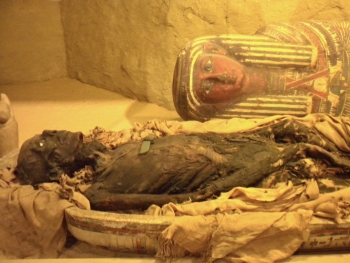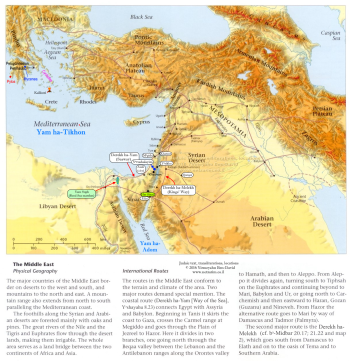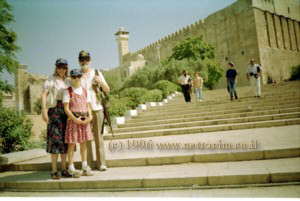
 |

 |
Yo•seiphꞋ fell upon his father's face and cried, kissing him. Then he commanded his staff, who were Egyptian doctors, to mummify his father. So the Egyptian doctors mummified Yi•sᵊr•â•eilꞋ, which was a 40-day mourning process.
So Ya•a•qovꞋ lived 60 chronological years (which included 70 figurative "Dark Days" years thinking Yo•seiphꞋ had been killed), totaling 130 years in Kᵊna•anꞋ. Living in Mi•tzᵊraꞋyim 17 chronological years then credited him with a total lifespan of 147 years.![]()
 |
 |
| Pâ•qidꞋ Yi•rᵊmᵊyâhꞋu, Karen & Yâ•eilꞋ at Mᵊâr•at′ ha-Ma•khᵊpeil•âhꞋ, opposite Ma•mᵊrei, in Khë•vᵊr•onꞋ (1996). |
After the Egyptian mummifying period had ended, Yo•seiphꞋ requested of Beit Par•ohꞋ to take his father's mummy back to Kᵊna•anꞋ and inter it in Mᵊâr•at′ ha-Ma•khᵊpeil•âhꞋ in Khë•vᵊr•onꞋ, Kᵊna•anꞋ. Par•ohꞋ agreed and sent a large delegation of Egyptian dignitaries, including chariots and horsemen—a huge delegation—to accompany the funeral procession.![]() So all of Beit Yo•seiphꞋ and his brothers and his father's household accompanied Yi•sᵊr•â•eilꞋ's mummy back to Khë•vᵊr•onꞋ for burial. They left behind in GōꞋshën only their toddlers and their tzon.
So all of Beit Yo•seiphꞋ and his brothers and his father's household accompanied Yi•sᵊr•â•eilꞋ's mummy back to Khë•vᵊr•onꞋ for burial. They left behind in GōꞋshën only their toddlers and their tzon.
 web10 threshing sled 250x380.jpg) |
When they came to The •tâdꞋ Threshing-Floor,![]() on the other
on the other![]() side of Nᵊhar Ya•rᵊd•einꞋ, there the Egyptian delegation diplomatically wept over the mummy of Yi•sᵊr•â•eilꞋ, for the customary ShëvꞋa days. When the Kᵊna•an•imꞋ saw the huge mourning by the Egyptian delegation the named the place Α•veilꞋ Mi•tzᵊraꞋyim.
side of Nᵊhar Ya•rᵊd•einꞋ, there the Egyptian delegation diplomatically wept over the mummy of Yi•sᵊr•â•eilꞋ, for the customary ShëvꞋa days. When the Kᵊna•an•imꞋ saw the huge mourning by the Egyptian delegation the named the place Α•veilꞋ Mi•tzᵊraꞋyim.
So Bᵊn•eiꞋ-Yi•sᵊrâ•eilꞋ did as he had commanded them, carrying his mummy back to Kᵊna•anꞋ and interring him in Mᵊâr•at′ ha-Ma•khᵊpeil•âhꞋ, opposite Ma•mᵊrei, which Avᵊrâ•hâmꞋ had bought from Ë•phᵊrōnꞋ the Khit•iꞋ.
After Yo•seiphꞋ finished burying his father, he and his brothers and everyone who had gone with them to bury his father returned to Mi•tzᵊraꞋyim.

Optional parental preparation:
 |
This large delegation of Egyptian dignitaries avoided confrontation with the Philistines, which would have been a provocation had they tried to take The Seaway. Further, such dignitaries would, by custom, have been likely to travel (via Ei•latꞋ) along The King's Way north of Yâm ha-MëlꞋakh to cross west over Nᵊhar Ya•rᵊd•einꞋ into Kᵊna•anꞋ at Yᵊri•khoꞋ.
The location of The •tâdꞋ Threshing-Floor is uncertain. The earliest evidence discovered so far is the Madaba map (6th century C.E.), showing the •tâdꞋ Threshing-Floor south of Yᵊri•khoꞋ near the north shore of Yâm ha-MëlꞋakh. This was renamed Α•veilꞋ Mi•tzᵊraꞋyim.
The circuitous route is approx. 500 km, at least a 17-day caravan, one-way. Plus the seven days shiv•âhꞋ and return trip totals a journey more than 40 days.![]()
Questions you might anticipate that your child might raise and be prepared to discuss:
What's a mummy and how is a deceased person mummified?
What does inter mean?
What is a delegation?
What does diplomatic mean?
What is mourning?
![]()
 |
 |